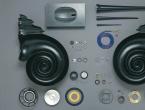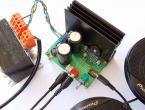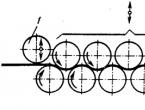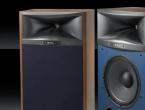2-way acoustic. Acoustic two-way system and its advantages. Features of three-way equipment
Presented in a fairly large assortment. This equipment differs from each other in the scope of application (instrumental, concert, studio and others), according to technical characteristics, body shape and many other qualities.
The most important parameter to consider first is the number of “lanes” in the system. According to this criterion, one-, three- and two-way acoustics are distinguished. How they differ from each other and which system is better, we will try to answer in this article.
Sound frequency
The human hearing organs are capable of detecting frequencies from 20 to 20,000 Hz.

Therefore, the quality of music directly depends on the ability of the equipment to create clear sound waves in a given range. For this purpose, they began to include speakers that reproduce exclusively low (20-150 Hz), medium (100-7000 Hz) and high (5-20 thousand Hz) frequencies. In this regard, the following appeared:
- Single-way systems, where the entire frequency range is produced by one speaker.
- Two-way acoustics, which have two speakers: one for playing music at medium and low frequencies, the second - only at high frequencies.
- Three-band equipment - a separate “column” is responsible for playing sounds in each range.
There is equipment with a large number of bands, where each speaker reproduces sound in a certain way. Two- and three-way systems are the most popular - they are the most affordable and provide excellent sound quality.
Advantages of two-way acoustics
Two-way speaker systems are most popular among motorists.

They provide optimal sound quality at an affordable price. Due to the development of technology, two-way is being replaced by three-way equipment, but it is still common due to its advantages:
- Simple design for easy installation and configuration.
- High degree of coherence between speakers, resulting in improved sound quality.
- Maximum natural, “live” sound.
In two-way equipment there are only two speakers - LF and HF. The woofer reproduces sounds in the low and mid ranges, and the tweeter only reproduces sounds in the high range. Because of this, simple separation filters are required for the system to operate.
Features of three-way equipment
Three-way acoustics differ from the already described system in that they have better sound. The equipment in such systems is equipped with a midrange speaker, which carries so-called “spatial” information and creates surround sound. In addition, thanks to the separation of duties, the equipment has become more compact.

The negative quality of three-way systems is their high price. It is two to three times higher than that of two-way acoustics. Moreover, three-way acoustics implies the installation of crossovers - complex frequency filters. To set up such equipment, you must have excellent hearing, otherwise you will not be able to achieve consistency from the speakers.
Differences between speaker systems
Any speaker system consists of speakers (midrange, bass and tweeter), filtering equipment, signal amplifiers, audio cables and input terminals. Filtering devices are responsible for dividing the sound signal into several ranges. A two-way acoustics filter divides frequencies into two “sections” - up to 5-6 thousand Hz, and above 6 kHz. Three-way devices are usually equipped with crossovers - adjustable frequency filters that divide the sound range into three sections.
All acoustic equipment can be active or passive. In the first case, each speaker is equipped with a separate signal amplifier. This solution facilitates matching of emitters and reduces the overall cost of the system. However, at the same time, the complexity of maintenance, installation and initial configuration increases. Separate amplifiers most often complement a set of three-way devices.
Coaxial and component speakers
How a three-way or two-way will sound largely depends on the type of speakers, which can be coaxial or component. The former are a single monolithic structure that combines high, medium and low frequency emitters. This solution makes the sound highly targeted. Therefore, such devices are used as a supplement and mainly in small cars.

Component speakers are emitters that can be placed in different places. Thanks to this, it is possible to achieve surround sound, but the process of installing equipment is complicated. Additionally, if installed incorrectly, the soundstage will be quite uneven. installed in cars with a spacious interior.
Question of price
As noted earlier, two-way acoustics will cost much less than installing three-way equipment. This is due to two reasons:
- less equipment - only two speakers, a maximum of two amplifiers and one filter are required;
- simple installation - you can assemble such a system yourself, having basic knowledge in the field of electricity.
Three-way systems include more complex equipment, the cost of which is significantly higher than the price of conventional devices. In addition, if you decide to install such acoustics, you will have to seek the help of professionals - without special measuring devices and fine hearing, the installed system will sound the same as two-way acoustics. This is the main answer to the question of how two-way acoustics differ from three-way ones.
PRO 6020 : 2-way Hi-End component audio system with a molded basket and a diffuser made of multilayer unpressed cellulose with the addition of cotton fiber Acoustic two-way component system PRO 6020 (165mm) was created by acoustic professionals for professionals and lovers of high-quality music reproduction. Every detail, every component of the system has been carefully selected. Much attention was paid even to such little things that, at first glance, are not directly related to high-quality sound reproduction. The audio system conveys three-dimensional space, giving the listener a sense of presence at a musical event. Fully controlled uncolored sound, powerful bass punch, stunning dynamics that strictly convey the spatial characteristics of the recording - this is how you can convey the sensations of the listener. Its excellent electro-acoustic performance and smooth, wide frequency response make it a top choice in highly dynamic installations. As a result of numerous laboratory tests and inspections, unpressed cellulose with the addition of cotton fiber was selected as the material for the manufacture of the woofer cone. This material has unique properties. It is very light and durable, but its main advantage is its excellent internal damping, so necessary for accurate sound transmission. This material is used to make speaker cones in high-end home speaker systems. Stable operation of the moving system is ensured by a cast anti-vibration basket with an anti-resonance coating, a powerful magnet, a multilayer voice coil made of copper-plated aluminum wire, a suspension made of butyl rubber and a specially designed centering washer. Gold-plated terminals provide a secure connection between the speaker contacts and the connecting wires. Accurate and easy reproduction of high frequencies is ensured by a 1 (25.4mm) inch neodymium magnet tweeter with a silk dome. The use of a copper-plated aluminum coil led to a reduction in the mass of the moving system, which made it possible to confidently reproduce the highest frequencies of the audio range. At the same time, the speaker is able to handle high power due to the better conductivity of the copper-plated wire and the presence of a ferromagnetic cooling liquid in the magnetic gap. Its rotatable design allows you to precisely select the desired position of the speaker in relation to the listener and ensure better coordination between the woofer and tweeter. The two-way crossover uses high-quality elements. The air-core crossover coils are wound with thick copper wire to reduce losses. The crossover cutoff frequency (2500Hz; 18dB/Oct) is optimized for the operation of an audio system in any type of car. It is possible to fine-tune the volume level of the tweeter (-3dB/0/+3dB). Another feature of the crossover is the possibility of its channel-by-channel connection, namely the tweeter and midbass separately (the so-called “bi-amping” circuit). To do this, you just need to cut a special technological loop in the crossover circuit. The "Absolute Sound" line is specially created for lovers of high-quality sound and is able to satisfy the requirements of the most demanding listener. This line combines the PRO 693, PRO 6020 and PRO 62D models. The acoustics of the "Absolute Sound" line are designed to work with external amplifiers in a wide power range.
2-way car speakers
The two-way acoustic system has long been very popular among motorists who value good sound. Today, three-way acoustics are an obvious competitor to this acoustics, but supporters of the old system still respect it and are not going to change it for anything.
Why a two-way speaker system is better and why it is so loved, we will find out from this article, where, among other things, instructions will be given on how to quickly install it in a car.
Advantages of two-way acoustics
As you know, all types of bandpass acoustics are divided into special classes. In this case we are talking about component and.
Coaxial acoustics
- It implies the presence of two heads installed in the speaker housing. Advantages: low cost and ease of installation.
Component acoustics
- Two speakers are combined into one complete system that reproduces low and high frequencies. The cost of such a system is much higher, which is understandable.
Front and rear acoustics
As you know, it is still customary to install speakers in a car depending on the direction of the sound.
- – this, in principle, is the installation of speakers in standard places, that is, in the front doors. Everything would be fine and there would be no problems if the standard seats were made in accordance with high-quality speakers.
But the fact is that on almost any car these very places intended by the manufacturer for installing speakers are very small and are designed for small-sized speakers. - Front acoustics take on the most important function - creating the correct sound stage in the car. At the same time, its installation involves the use of special door linings followed by strong fastening of the speakers.
- Frontal acoustics usually involve installing speakers in the upper parts of the front doors.
- To achieve the best sound effect, 2-way speakers should be mounted so that its elements are as close to each other as possible. This means installing the woofer in the door, and the tweeter on the pillar or dashboard of the car.
Advantages of front acoustics:
- Installation will be quick and easy.
- In the case of a 2-way system, there will be practically no difficulties during installation.
- On the other hand, installation in a door implies the absence of a housing for the speaker, which can negatively affect the sound quality. In this regard, craftsmen come up with various and original ones that enhance the sound effect from the speakers.
As mentioned above, the main thing in a car is the rear acoustics. As for this system, it will serve as an additional sound effect.
So:
- The use of rear acoustics is justified, because the speakers in this case improve the overall background sound, making the sound picture much deeper.
- 2-way speakers sound better, of course, from the front, but also from the back in the trunk or on an acoustic shelf, their midrange frequencies will sound good.
- Installing rear speakers also involves making a special acoustic shelf, which helps the speakers sound better.
Installation of 2-way acoustics
So, as it became clear, the complete installation of 2-way acoustics in a car implies its use both in the front and in the rear.
Front doors:
Note. For installation in the front doors, it is advisable to use 16 cm speakers.
- We purchase or make our own podiums for speakers.
Note. It is worth noting that the podiums themselves are unlikely to provide strength to the speakers. Therefore, a board is made separately for the podiums or special linings made of chipboard or plywood are placed under them.
- We are modifying the doors, increasing the dimensions to accommodate the installation of 16 cm speakers. Also at this stage, a strong support is installed, which must be firmly screwed to the metal part of the door.
- We create an acoustic volume by sealing the door openings with masking tape. We cover the tape with fiberglass cloth, which, in turn, is impregnated with epoxy glue.
- If you make the podiums yourself, you will first need to cut out rings with 4 ears from plywood. These same ears will be needed to attach the podium to the door.
Then we make 2 intermediate rings for each podium and assemble everything together, also using spacers. - We firmly screw the podiums to the door.
- We cover the door with vibroplast.
Note. The crossover can be installed next to the door handle, because in this place it will be quite free to be (depending on the car model).
The instructions given above will help you avoid making mistakes when choosing and installing this acoustic system yourself. During the installation process, it is recommended to study photo and video materials.
As you know, the price of installing audio systems in a car from professionals is always high, so there is a reason to learn how to do everything yourself.
We'll tell you about the stages of a typical installation of component 2-way acoustics in the front doors.
By the way, this work in our installation center costs from 2,500 rubles. and takes about 2 - 2.5 hours.
This article will use photographs of different car models that visited the installation center.
So, what happens to the car after acceptance:
- Remove the door trim.
- We dismantle the standard acoustics.

- We make podiums from plywood according to the dimensions of standard acoustics. Sometimes simple in form, sometimes complex. In this case, two important conditions must be met:
The new speaker system should be located as close as possible to the standard door trim grids, but not touch them.
After installing the new acoustics, its magnet should not touch the internal elements of the door.
- We treat plywood rings with stain, since untreated plywood very quickly becomes unusable.

We install a podium on the door. We install a seal between the podium and the door so that there are no gaps. If the new speaker system has no more than average power, then we fix the new podium using self-tapping screws into the standard holes.
- We install crossovers in the doors (if the beepers are installed in the doors) or in the cabin (if the beepers are on the pillars or the front panel).

- We run new speaker wires through the doors if crossovers are installed in the cabin. We only pull through the standard corrugations.
- Solder the wires to the speaker terminals.
- We install new acoustics on new podiums.


- Turn on the audio. We check that all components are connected correctly for polarity using special equipment. We check for the absence of interference and overtones.
- We install the door trim in place.
- Once again we listen to the results for the absence of overtones and interference.
- We clean up after ourselves in the car.
Installing car audio components requires certain knowledge and experience. We recommend that you either outsource this work to professionals in the field of car audio (not to be confused with auto electricians), or do everything yourself.
The crooked hands of an amateur can ruin the sound of even very good components.
2-way/wideband open type speakers. At the design stage:
Technical characteristics in 2-way mode:
Frequency range: 100 – 20000 Hz (100 – 19000 Hz)
Frequency response unevenness in the range 100-20000 Hz: ±8 dB (±10 dB)
Sensitivity: 90 dB (90 dB)
Resistance: 8 ohms (8 ohms)
Nameplate power: 10 W (10 W)
Long-term power: 12 W (12 W)
Short-term power: 40 W (40 W)
Speakers used:
Dimensions (HxWxD): 530x350x75 mm
Weight of one speaker: 5 kg
The data in parentheses is in broadband mode.
Frequency response of the acoustic system and speakers in the housing. The measurement conditions are the same (microphone from 1 m, delay 5 ms, smoothing 1/24 oct). All charts are signed:
Shp speakers, direct
2-way. 3 mH on the SB speakers + 1 µF on the HF. In phase
HF speaker with 1 µF capacitor
HF speaker with 2.2 µF capacitor
2-way. On the SB speakers 0.25 mH + 2.2 µF on the HF. In phase
Frequency response of the system. 2-way mode. 0.25 mH at SB + 1 µF at HF. In phase
Description:
The acoustic system is designed in . The speaker body is made of 10 mm thick plywood. Externally, the plywood is covered with oak veneer and treated with wood oil. On the inside, the side walls are additionally connected to the front panel through triangles made of the same plywood, which gives the body additional rigidity and has a positive effect on the dispersion of sound waves.
Cases are glued
Irregularities are puttied before veneer
The front panel is covered by a removable grill with stretched fabric. The grill is also made of plywood and is attached with screws. The speakers are located along the vertical axis; between the broadband speakers there is a tweeter. On the inside of the front panel there is a filter, terminals and a switch. The wiring is made with acoustic cable.
Removable grill
Hole in grill for mortise nut
Mortise nuts allow the screw to be tightened from one side
The mortise nut is installed
The grills are painted black, the fabric is stretched
The fabric is fixed with staples
The filter diagram and switching between operating modes is shown below. The 1st order filter consists of an MBGO capacitor and an air-core inductor. Network toggle switch 250V/15A. Acoustic wiring. Terminals are chrome plated, with a spring.
Diagram of the filter and the speaker system as a whole:
Operating modes:
Work in 2-lane mode. Contacts 1-3 and 2-4 are closed. The signal from the positive terminal comes to point 3. In this mode, points 1, 2, 3 and 4 form a single point, from which the signal diverges to the capacitor and coil, the speakers of the ShP and HF, and then to the negative terminal. Pin 5 is in the air. Pin 6 is not used.
Broadband operation. Contacts 3-5 and 4-6 are closed. The signal from the positive terminal comes to point 3 and jumps to point 5, from which it is supplied to a pair of ShP speakers and to the negative terminal. Pins 1 and 2 are in the air, thereby cutting off the tweeter and its filter. Pin 6 is not used.
Front view, without grill
Close-up
Back view
Close-up
The elements of the circuit are attached with self-tapping screws and screws, everything is quite simple
Thanks to two operating modes, the listener has the opportunity to choose between a convenient speaker operating option. Higher sensitivity, but the frequency response curve and few high frequencies (WB mode) or less high sensitivity, but the frequency response is smoother and the high frequencies will reach 20 kHz. By ear, two-way operation is practically no different from broadband.
Front view
The front panel is slightly peered through the mesh




